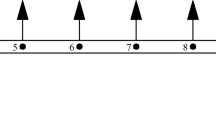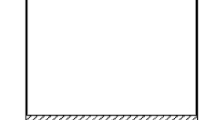Abstract
Long-term structural health monitoring (SHM) requires processing a large amount of data with human intervention often involved. Operational modal analysis (OMA) is generally treated as prerequisite for vibration-based SHM to obtain modal parameters, including natural frequency, damping ratio and mode shape. Bayesian modal analysis has received considerable attention in recent years, as it identifies modal parameters but also provides their uncertainties. In conventional Bayesian OMA, manual operation includes initial frequency and bandwidth selection. The former is often visually picked from a singular value spectrum, while the latter is chosen with the consideration of a trade-off between the data used for making inference and modeling error involved. The above procedures have limited the application of Bayesian approach in processing long-term data. This work aims at developing an automation technique for Bayesian fast Fourier transform modal identification. A stabilization diagram is first built and automatically interpreted by modal validation criteria and clustering strategy to obtain the initial frequency. Spurious modes are also cleared in this step. A series of effective bandwidth factors within a predefined factor range are then determined for the selection of frequency band. The proposed automation method is verified by a numerical example and then applied on the Z24 benchmark bridge for long-term data analysis. Results show that the automation method is able to accurately identify modal parameters with minimum human intervention, even for closely spaced and weakly excited modes. It is also shown that the method is adequate to automatically analyze long-term monitoring data.



























Similar content being viewed by others
Data available statement
Data, models, and codes generated and used during the study are available from the corresponding author upon reasonable request.
Change history
07 January 2023
A Correction to this paper has been published: https://doi.org/10.1007/s13349-022-00665-2
References
Lee H, Kim J, Sho K et al (2010) A wireless vibrating wire sensor node for continuous structural health monitoring. Smart Mater Struct 19(5):055004
Gentile C, Ruccolo A, Canali F (2019) Continuous monitoring of the Milan Cathedral: dynamic characteristics and vibration-based SHM. J Civ Struct Heal Monit 9(5):671–688
Farrar CR, Worden K (2010) An introduction to structural health monitoring. In: New trends in vibration based structural health monitoring, pp 1–17
Pereira S, Magalhães F, Gomes JP et al (2021) Modal tracking under large environmental influence. J Civil Struct Health Monitor
Brownjohn J, Magalhaes F, Caetano E et al (2010) Ambient vibration re-testing and operational modal analysis of the Humber Bridge. Eng Struct 32(8):2003–2018
Yang X-M, Yi T-H, Qu C-X et al (2019) Automated eigensystem realization algorithm for operational modal identification of bridge structures. J Aerosp Eng 32(2):04018148
Zhang G, Ma J, Chen Z et al (2014) Automated eigensystem realisation algorithm for operational modal analysis. J Sound Vib 333(15):3550–3563
Ye X, Huang P, Pan C et al (2021) Innovative stabilization diagram for automated structural modal identification based on ERA and hierarchical cluster analysis. J Civ Struct Heal Monit 11(5):1355–1373
Cabboi A, Magalhães F, Gentile C et al (2017) Automated modal identification and tracking: application to an iron arch bridge. Struct Control Health Monit 24(1):e1854
He M, Liang P, Li J et al (2021) Fully automated precise operational modal identification. Eng Struct 234:111988
Sarlo R, Tarazaga PA, Kasarda ME (2018) High resolution operational modal analysis on a five-story smart building under wind and human induced excitation. Eng Struct 2018(176):279–292
Charbonnel PÉ (2021) Fuzzy-driven strategy for fully automated modal analysis: application to the SMART2013 shaking-table test campaign. Mech Syst Signal Process 152:107388
Vanlanduit S, Verboven P, Guillaume P et al (2003) An automatic frequency domain modal parameter estimation algorithm. J Sound Vib 265(3):647–661
Peeters B, Van der Auweraer H (2005) PolyMAX: a revolution in operational modal analysis. In: 1st International Operational Modal Analysis Conference. IOMAC Copenhagen, Denmark
Reynders E, Houbrechts J, De Roeck G (2012) Fully automated (operational) modal analysis. Mech Syst Signal Process 2012(29):228–250
Zonno G, Aguilar R, Boroschek R et al (2018) Automated long-term dynamic monitoring using hierarchical clustering and adaptive modal tracking: validation and applications. J Civ Struct Heal Monit 8(5):791–808
Beck JL, Katafygiotis LS (1998) Updating models and their uncertainties. I: Bayesian statistical framework. J Eng Mech 124(4):455–461
Yuen K-V, Katafygiotis LS (2003) Bayesian fast Fourier transform approach for modal updating using ambient data. Adv Struct Eng 6(2):81–95
Katafygiotis LS, Yuen KV (2001) Bayesian spectral density approach for modal updating using ambient data. Earthquake Eng Struct Dynam 30(8):1103–1123
Yuen KV, Beck JL, Katafygiotis LS (2002) Probabilistic approach for modal identification using non-stationary noisy response measurements only. Earthquake Eng Struct Dynam 31(4):1007–1023
Au S-K (2011) Fast Bayesian FFT method for ambient modal identification with separated modes. J Eng Mech 137(3):214–226
Au S-K (2012) Fast Bayesian ambient modal identification in the frequency domain, Part II: posterior uncertainty. Mech Syst Signal Process 26:76–90
Zhu Z, Au S-K, Li B et al (2021) Bayesian operational modal analysis with multiple setups and multiple (possibly close) modes. Mech Syst Signal Process 150:107261
Zhu Y-C, Xie Y-L, Au S-K (2018) Operational modal analysis of an eight-storey building with asynchronous data incorporating multiple setups. Eng Struct 165:50–62
Zhang FL, Xiong HB, Shi WX et al (2016) Structural health monitoring of Shanghai Tower during different stages using a Bayesian approach. Struct Control Health Monit 23(11):1366–1384
Au S-K, Zhang F-L (2011) On assessing the posterior mode shape uncertainty in ambient modal identification. Probab Eng Mech 26(3):427–434
Ni Y-Q, Zhang F-L, Xia Y-X et al (2015) Operational modal analysis of a long-span suspension bridge under different earthquake events. Earthquakes and structures 8(4):859–887
Zhang F-L, Ni Y-Q, Ni Y-C (2016) Mode identifiability of a cable-stayed bridge based on a Bayesian method. Smart Struct Syst 17(3):471–489
Au S-K (2016) Model validity and frequency band selection in operational modal analysis. Mech Syst Signal Process 81:339–359
Au S-K (2012) Fast Bayesian ambient modal identification in the frequency domain, Part I: posterior most probable value. Mech Syst Signal Process 26:60–75
Reynders E, Pintelon R, De Roeck G (2008) Uncertainty bounds on modal parameters obtained from stochastic subspace identification. Mech Syst Signal Process 22(4):948–969
Zeng J, Hoon Kim Y (2021) A two-stage framework for automated operational modal identification. Struct Infrastruct Eng. https://doi.org/10.1080/15732479.2021.1919151
Peeters B, De Roeck G (1999) Reference-based stochastic subspace identification for output-only modal analysis. Mech Syst Signal Process 13(6):855–878
Fan G, Li J, Hao H (2019) Improved automated operational modal identification of structures based on clustering. Struct Control Health Monit 26(12):e2450
de Almeida Cardoso R, Cury A, Barbosa F (2017) A clustering-based strategy for automated structural modal identification. Struct Health Monit 17(2):201–217
Sun M, Alamdari MM, Kalhori H (2017) Automated operational modal analysis of a cable-stayed bridge. J Bridg Eng 22(12):05017012
Li B, Au S-K (2019) An expectation-maximization algorithm for Bayesian operational modal analysis with multiple (possibly close) modes. Mech Syst Signal Process 132:490–511
Pereira S, Reynders E, Magalhães F et al (2020) The role of modal parameters uncertainty estimation in automated modal identification, modal tracking and data normalization. Eng Struct 224:111208
Li J, Bao T, Ventura CE (2022) An automated operational modal analysis algorithm and its application to concrete dams. Mech Syst Signal Process 168:108707
Lorenzoni F, Casarin F, Caldon M et al (2016) Uncertainty quantification in structural health monitoring: applications on cultural heritage buildings. Mech Syst Signal Process 66:268–281
Cruz C, Miranda E (2017) Evaluation of the Rayleigh damping model for buildings. Eng Struct 138:324–336
Elmenshawi A, Sorour M, Mufti A et al (2010) Damping mechanisms and damping ratios in vibrating unreinforced stone masonry. Eng Struct 32(10):3269–3278
Au S (2017) Operational modal analysis: modeling, Bayesian inference, uncertainty laws. Springer, Singapore
Mao JX, Wang H, Fu YG et al (2019) Automated modal identification using principal component and cluster analysis: Application to a long‐span cable‐stayed bridge. Struct Control Health Monitor 26(10)
Tran TTX, Ozer E (2020) Automated and model-free bridge damage indicators with simultaneous multiparameter modal anomaly detection. Sensors (Basel) 20(17)
Wu W-H, Wang S-W, Chen C-C et al (2018) Modal parameter identification for closely spaced modes of civil structures based on an upgraded stochastic subspace methodology. Struct Infrastruct Eng 15(3):296–313
Priori C, De Angelis M, Betti R (2018) On the selection of user-defined parameters in data-driven stochastic subspace identification. Mech Syst Signal Process 100:501–523
Charbonnel P-É (2021) Fuzzy-driven strategy for fully automated modal analysis: application to the SMART2013 shaking-table test campaign. Mech Syst Signal Process 152:107388
He Y, Yang JP, Li X-F (2022) A three-stage automated modal identification framework for bridge parameters based on frequency uncertainty and density clustering. Eng Struct 255:113891
Afshar M, Khodaygan S (2019) Enhanced stabilization diagram for automated modal parameter identification based on power spectral density transmissibility functions. Struct Control Health Monit 26(7):e2369
Pan C, Ye X, Mei L (2021) Improved automatic operational modal analysis method and application to large-scale bridges. J Bridg Eng 26(8):04021051
Ubertini F, Gentile C, Materazzi AL (2013) Automated modal identification in operational conditions and its application to bridges. Eng Struct 2013(46):264–278
Au S-K, Brownjohn JM, Mottershead JE (2018) Quantifying and managing uncertainty in operational modal analysis. Mech Syst Signal Process 102:139–157
Maeck J, De Roeck G (2003) Description of Z24 benchmark. Mech Syst Signal Process 17(1):127–131
Peeters B, De Roeck G (2001) One-year monitoring of the Z24-Bridge: environmental effects versus damage events. Earthquake Eng Struct Dynam 30(2):149–171
Worden K, Cross EJ (2018) On switching response surface models, with applications to the structural health monitoring of bridges. Mech Syst Signal Process 98:139–156
Cigada A, Caprioli A, Redaelli M et al (2008) Vibration testing at Meazza stadium: reliability of operational modal analysis to health monitoring purposes. J Perform Constr Facil 22(4):228–237
Acknowledgements
The first author would like to express gratitude and sincere appreciation for the partial financial support by the University of Louisville. The second author is funded by the National Key R&D Program of China (2019YFB2102702) and Shenzhen Science and Technology Program (JSGG20210802093207022). Authors would also like to acknowledge KU. Leuven for the open access data used in this paper.
Author information
Authors and Affiliations
Corresponding author
Ethics declarations
Conflict of interest
The authors declare no potential conflict of interests.
Additional information
Publisher's Note
Springer Nature remains neutral with regard to jurisdictional claims in published maps and institutional affiliations.
The original online version of this article was revised: " In this article the authors Jice Zeng, Young Hoon Kim and Yan-Long Xie afliation details was corrected.
Rights and permissions
Springer Nature or its licensor (e.g. a society or other partner) holds exclusive rights to this article under a publishing agreement with the author(s) or other rightsholder(s); author self-archiving of the accepted manuscript version of this article is solely governed by the terms of such publishing agreement and applicable law.
About this article
Cite this article
Zeng, J., Xie, YL., Kim, Y.H. et al. Automation in Bayesian operational modal analysis using clustering-based interpretation of stabilization diagram. J Civil Struct Health Monit 13, 443–467 (2023). https://doi.org/10.1007/s13349-022-00644-7
Received:
Accepted:
Published:
Issue Date:
DOI: https://doi.org/10.1007/s13349-022-00644-7




